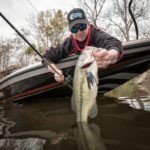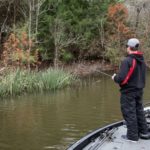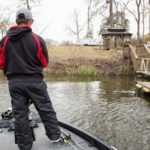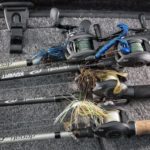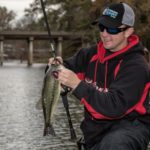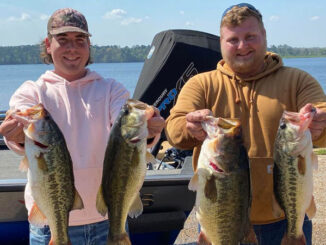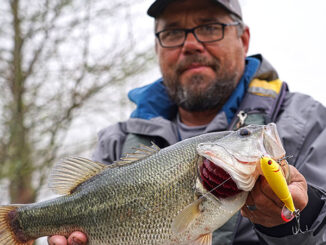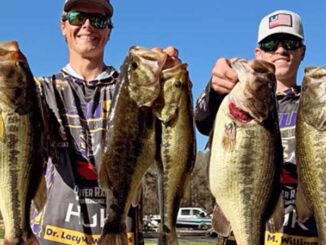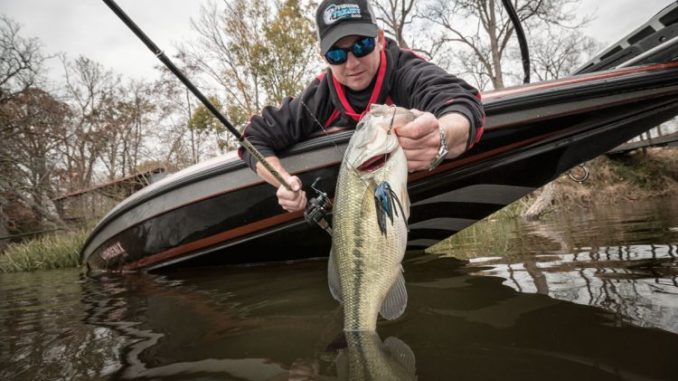
Even in tough wintertime conditions, Black River Lake in central Louisiana can deliver bass — if you crack the code.
I’ve got to admit I wasn’t expecting much.
Chad Wiley, a Bassmaster tournament pro from Pineville, asked me to meet him at Joe’s Horseshoe Lake Marina in Monterey.
Except for the cold front that had blown through the night before, I wouldn’t have been so pessimistic.
The wind was predicted to gust up to 25 miles an hour, and the sun that was forecasted didn’t want to peek out from behind the heavy, low-hanging clouds.
When I walked down the ramp to jump into Wiley’s boat, I was greeted by water that looked like two Yoo-hoo trucks had just collided on the bridge across Cocodrie Bayou.
To make matters worse, I was dressed more for the forecast high of 58 — rather than the actual temperature of 45.
But I didn’t drive 2 ½ hours for nothing, so I bucked up, drew my hood down and rode along with Wiley to wherever the heck he was going.
“Last weekend was my first time to ever fish here,” he announced, as he came off plane near a bridge where a guy in a small aluminum boat was trying to jerk up a few white perch.
If the cold front had diminished my expectations, Wiley’s revelation just crushed them to smithereens: I had driven halfway across Louisiana to fish a lake with a guy that had only fished it one other time in his entire life.
He attempted to explain as we idled under the bridge.
“I spent most of the day fishing that lake we just came from — Horseshoe — and wasn’t doing anything but hauling water,” he said. “I figured I had to do something, so I pulled up and ran over to Black River Lake. By the time it was over, I had 15 pounds swimming in my livewell.”
But we were only a week removed from his first foray into Black River Lake, so maybe things wouldn’t be as bad as I had feared.
Maybe… just maybe… those fish would still be where he had found them the Saturday before.
“Only problem today is the water has fallen out a foot, and it’s 5 degrees colder than it was last week,” Wiley announced.
Well, so much for that thought.
Go to the green
Wiley started slinging a chartreuse squarebill crankbait before I could even get out of my seat and immediately had a small bass stretching his line. It was a start, but unfortunately it didn’t last.
“They didn’t eat it last week either,” Wiley said. “I was hoping that with the water falling out a foot it would have pulled some of them out from the thick stuff.
“They were up in these green reeds during the tournament,” Wiley continued, after he got to the end of another clump. “Bass like vegetation this time of year… got to go to the green. The vegetation is going to hold more algae. The algae attracts plankton. The plankton attract shad. The shad attract bass. Sometimes you’ve got to go in and get them, though.”
After giving up on the crankbait, Wiley picked up a jig. He ran to another patch of reeds on the other side of the lake and started pitching it a foot back into the vegetation.
“That’s where they were last week,” he said. “It was already starting to fall out a little bit, but they were still in that last zone before they pull out entirely. We had about an hour of sun and that just kept them in there later in the day.”
Wiley started swimming his jig away from the grass as he wrapped up the next cast — and it was engulfed by a bass about halfway back to the boat.
“If I would have been paying attention, I would have lost this bass,” Wiley said. “He dropped it then came back for it. I’d have yanked on it the first time just out of reaction. I think today we’re going to have to feel for them a little bit and let them eat it.”
After a second bass ate his jig about a foot in front of the grass, Wiley began to put a pattern together.
Rather than being up in the grass, bass were suspended a foot down in front of the reeds. With the heavy baits we were fishing, those bass had no time to decide if they wanted to bite or not. It was all reaction.
Cracking the code
Pattern in hand, Wiley took off trying to make a milk run of reeds he had marked on his GPS the weekend before. But the pattern didn’t hold up at the next two patches he visited.
“Something’s missing,” he noted. “I thought I had them figured out. We’re doing the same thing we did when they started eating this jig. Guess we’ll just keep running these reeds until we hit another little group of fish.”
But the next stop completely clued him in on what was going on. Trying to put the puzzle together, Wiley realized that the first two patches of reeds where he got bit had a dock close by. This patch had the exact same setup.
“That’s it,” he announced. “I bet we can run reeds that have docks all over this lake and catch fish.”
While proving his point over and over again, Wiley asked me if I noticed anything different about the reeds we were targeting. I had to admit that I had not.
“Every patch with a fish on it has been green,” he said. “Look at that patch over there. See how they’re turning yellow. We haven’t caught a fish off a yellow patch of reeds yet. The ones that are productive are still bright green and full of life.”
As we bounced around among patches of reeds, Wiley continued pitching a combination of a heavy slip-jig and a heavy Texas rig with a electric blue plastic crawfish.
Go heavy for reaction bites
With the way the fish were acting, he felt like a heavy presentation put the odds more in his favor than a lighter jig or weight would.
“We’ve been told all our lives to fish the lightest weight the conditions will allow,” he said, “but as you can tell there’s something about these heavy baits that just works. There’s nothing finesse about it.
“You don’t have to tease them into biting. Heavy baits are a no-holds-barred way of fishing where you put your bait in there with them, knock them on the head and make them react.”
He went on to say that heavy baits seem to work particularly well during difficult conditions like we had that day. Instead of hoping a hungry bass finds his slow moving bait, Wiley would rather make more pitches and cover more water.
“The more pitches the more chances I have of getting bit,” he added. “Take all these fish we caught today. We might have caught them on a light weight, but we’d still be back there working the second or third patch of reeds instead of working our 12th or 13th patch.”
As we were reeling in our lasts casts, Wiley explained that the Horseshoe/Black River Lake complex reminded him a lot of Saline/Larto — the one notable exception being the deeper water of Black River Lake.
Wintertime bass hotspots
Both complexes are made up of two larger bodies of water connected by a series of bayous and cuts. And they are both considered exceptional spots for wintertime bass fishing.
“They both get fed by the river,” Wiley explained, “but Horseshoe and Black River Lake kind of get fed from the back. Both are full of shad… I’ve seen piles of shad here just like at Saline/Larto. They also both have a lot of shallow targets with conditions that generally keep bass shallow all year long.”
Although we stuck primarily with the jig and Texas-rig, Wiley explained how he would have approached Horseshoe/Black River if the conditions had been a little different.
First of all, if the water wasn’t as high, he believed a football jig or a Strike King 5XD crankbait would have worked well on the docks.
“If this water wasn’t up it wouldn’t be in those reeds,” he said. “They wouldn’t have many other options except for the docks and maybe a few lay-downs. And believe it or not, I would try a jigging spoon under some of these floating docks over deep water. Sounds crazy to fish a jigging spoon in Louisiana, but it works.”
Wiley added that a spinnerbait would have worked well fished parallel to the outside edge of the reeds, especially considering that’s where the bass were positioned.
Like the earlier fish that bit his crankbait, though, he thought any spinnerbait fish would have been smaller than the ones that were biting the jig.
As we motored back through Workinger Bayou headed to Horseshoe, Wiley pointed out that this chute connecting the two larger bodies of water was a good place to fish as well.
“I love it when it’s right,” he said. “It’s pure junk fishing… strap 15 rods on your deck and go fishing. When the water falls out these fish have to transition somewhere since we don’t have a lot of typical transition structures like ledges and true creeks. They use the lay-downs to move up and down on instead.”
Match the hatch? Not this time.
Most of the time, Wiley says shad are going to be on those lay-downs — so it would make sense to throw a shad bait, right?
“Nope!”’ he insisted. “I’d rather throw a jig. If we’re standing here and it’s raining pennies, and I throw a penny up in the air, are you going to catch it? Probably not. But if I throw a dollar bill in those pennies, you’re going to fight for it all the way to the ground. That’s why I like throwing jigs in lay-downs during the winter. A jig is the dollar bill of the pennies.”
Although we didn’t fish Horseshoe Lake because of the extremely muddy water, Wiley told me as we were loading his boat that it was a great place to fish, too — especially if you like fishing cypress trees.
“It’s typical Louisiana cypress tree fishing,” he said. “The only problem with Horseshoe is it’s the first place to get water, so it’s the first of the two to get all messed up when river water is coming in. If it’s right, you can go out there and catch them on jigs, crankbaits and spinnerbaits around those trees. But when it’s so muddy you can’t see your bait an inch under water, head to Black River Lake instead.”
Black River Lake is the last spot to get water. It’s kind of like the back end of a big pocket or the back of a dead-end canal. Add the deeper water and you’ve got a spot that will fish right all winter long, no matter the conditions.
It’s not how you start ….
On a day that I didn’t even want to be on the water, Wiley and I landed 16 bass that ranged from 2 to 4 pounds. All came on jigs or Texas rigs fished around reed patches that had docks nearby.
“If we would have looked around those docks with the sonar, I bet we would have seen some brushpiles,” Wiley concluded. “The fish were probably in those piles before the water jumped up. When it did, they chased the food-chain effect right into those reeds.”
Considering I had no expectations, it’s easy to say the Horseshoe/Black River Lake complex exceeded them. But that wouldn’t be fair.
In fact, if I would have had great expectations, I still wouldn’t have left disappointed.
